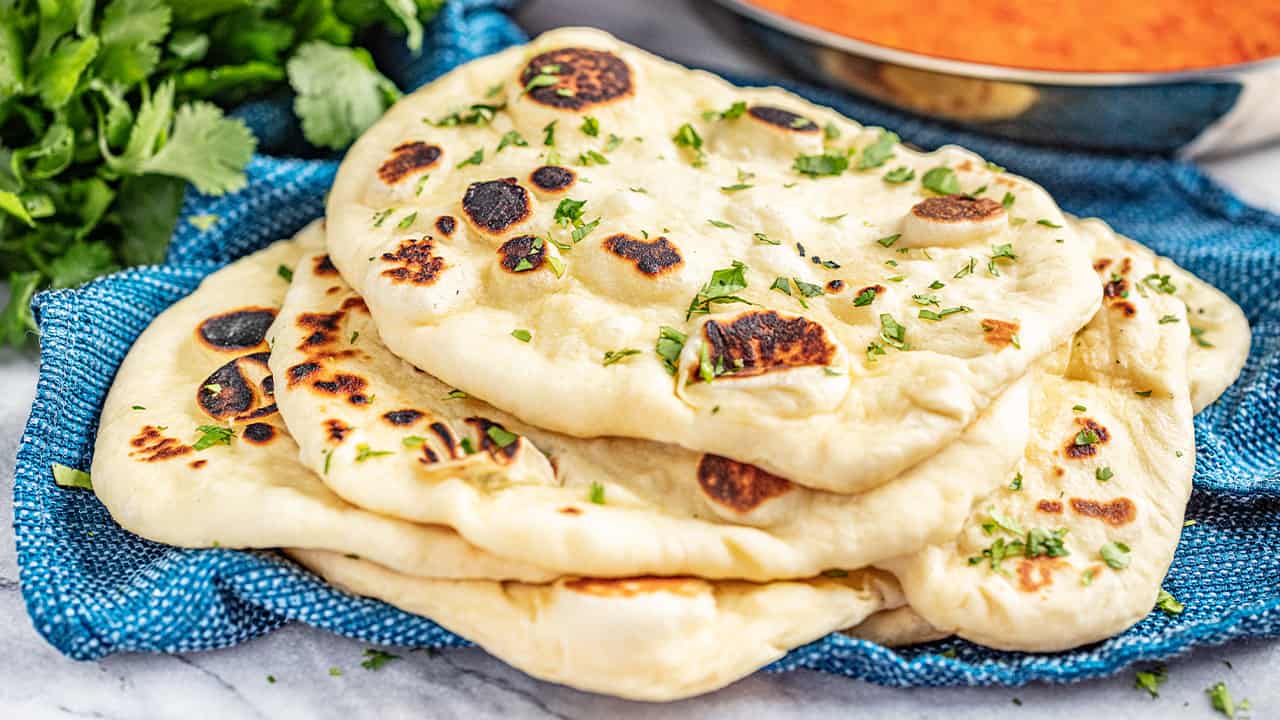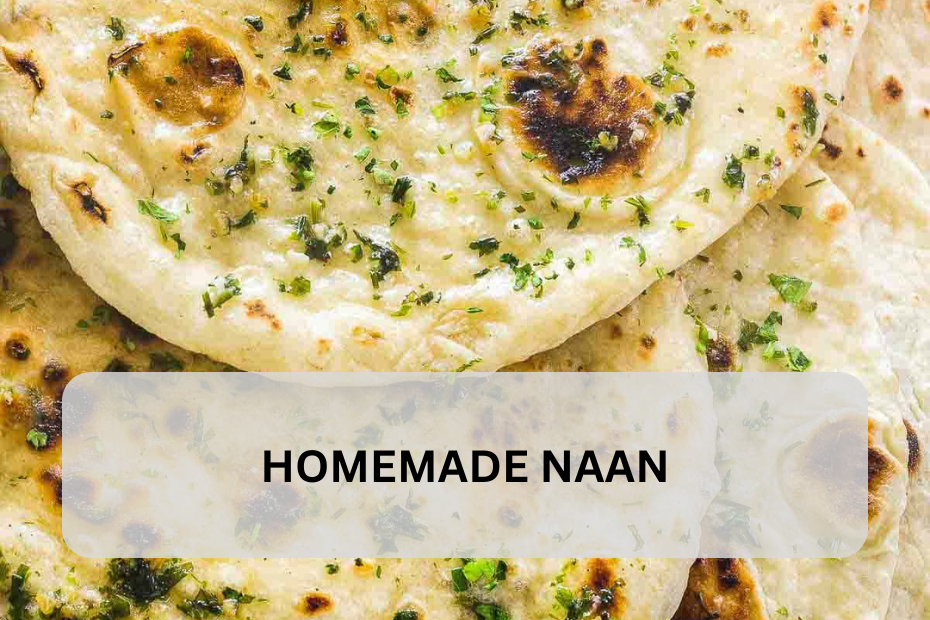Naan, a versatile and beloved Indian flatbread, has gained popularity worldwide for its soft texture and ability to complement a wide range of dishes. This article explores the origins of naan, provides a detailed recipe for making it at home, suggests variations to suit different tastes, discusses its nutritional aspects, offers serving suggestions, and delves into its cultural significance.
Origins and Cultural Significance

Naan bread has ancient roots in Persia (modern-day Iran), where it was traditionally cooked in tandoor ovens, known for their high heat and ability to impart a distinct smoky flavor. The word “naan” itself is derived from the Persian word “non,” meaning bread. As trade routes expanded, naan traveled to the Indian subcontinent and Central Asia, where it became an integral part of local cuisines.
In Indian culture, naan is often associated with festive occasions, celebrations, and communal meals. It serves as a versatile accompaniment to various dishes, from rich curries to grilled meats and vegetarian fare. Naan’s popularity in Indian restaurants and households worldwide highlights its universal appeal and adaptability to different culinary preferences.
Ingredients for Homemade Naan
To prepare delicious homemade naan, gather the following ingredients:
- All-Purpose Flour: 3 cups, plus extra for dusting.
- Yogurt: 1/2 cup, plain Greek yogurt works well.
- Warm Water: 1/2 cup, approximately.
- Sugar: 1 tablespoon.
- Active Dry Yeast: 2 teaspoons.
- Salt: 1 teaspoon.
- Baking Powder: 1/2 teaspoon.
- Melted Ghee or Butter: 3 tablespoons, plus extra for brushing.
- Garlic (Optional): 2-3 cloves, minced, for garlic naan.
- Fresh Cilantro (Optional): Chopped, for garnish.
Step-by-Step Recipe for Homemade Naan
Step 1: Activate the Yeast
- Proof Yeast: In a small bowl, combine warm water, sugar, and yeast. Stir gently and let it sit for 5-10 minutes until frothy.
Step 2: Prepare the Dough
- Mix Dry Ingredients: In a large mixing bowl, whisk together all-purpose flour, salt, and baking powder.
- Add Wet Ingredients: Make a well in the center of the flour mixture and pour in the activated yeast mixture, yogurt, and melted ghee or butter.
- Knead Dough: Mix with a wooden spoon until a rough dough forms. Then, transfer to a floured surface and knead for 8-10 minutes until smooth and elastic. Add more flour if needed to prevent sticking.
Step 3: Let the Dough Rise
- First Rise: Place the dough in a lightly greased bowl, cover with a damp cloth or plastic wrap, and let it rise in a warm place for 1-2 hours until doubled in size.
Step 4: Shape and Cook the Naan
- Preheat Oven or Skillet: If using an oven, preheat to the highest setting (typically around 500°F or 260°C) with a pizza stone or baking sheet inside. Alternatively, heat a cast-iron skillet or griddle over medium-high heat for stovetop cooking.
- Divide Dough: Punch down the risen dough and divide it into 8-10 equal-sized portions. Roll each portion into a ball.
Step 5: Roll and Cook Naan
- Roll Out Naan: On a floured surface, roll out each dough ball into an oval or teardrop shape, about 1/4 inch thick.
- Cook in Oven: If using an oven, carefully place the rolled-out naan on the preheated pizza stone or baking sheet. Bake for 2-3 minutes until puffed up and lightly browned. Brush with melted ghee or butter immediately after removing from the oven.
- Cook on Stovetop: If using a skillet or griddle, cook each rolled-out naan for 1-2 minutes on each side until puffed and lightly browned. Brush with ghee or butter after flipping.
Step 6: Serve
- Garnish: For garlic naan, sprinkle minced garlic and chopped cilantro over the hot naan.
- Serve Warm: Serve homemade naan warm, accompanied by your favorite curries, dips, or as a standalone snack.
Variations of Homemade Naan

Homemade naan offers endless possibilities for customization:
- Garlic Naan: Mix minced garlic into the dough and sprinkle more on top before cooking.
- Butter Naan: Brush with generous amounts of melted butter before serving.
- Cheese Naan: Sprinkle grated cheese (like mozzarella or paneer) on top of the naan before cooking.
- Whole Wheat Naan: Substitute part or all of the all-purpose flour with whole wheat flour for a healthier option.
- Stuffed Naan: Fill with ingredients such as spiced potatoes (aloo naan), paneer (paneer naan), or minced meat.
Cultural Significance and Regional Adaptations
Naan has evolved differently across regions, with each area adding its own twist:
- North India: Known for its fluffy texture and often served with robust curries like butter chicken or palak paneer.
- South India: Variants like “Kerala Parotta” are flakier and often served with spicy gravies or chutneys.
- Pakistani Cuisine: Naan is a staple, often enjoyed with kebabs or as a wrap for grilled meats.
- Afghan Naan: Larger and thicker, often topped with sesame seeds or nigella seeds.
Nutritional Insights
While naan is delicious, it’s essential to consider its nutritional aspects:
- Calories: Naan is calorie-dense due to the flour and ghee/butter used.
- Protein: Yogurt adds some protein, but naan is not a significant source.
- Carbohydrates: Provides energy from carbohydrates, which are essential for daily activities.
- Portion Size: Control portion sizes to balance with other nutritious foods like vegetables and lean proteins.
Serving Suggestions
Homemade naan complements a wide range of dishes and flavors:
- Curries: Serve with classic Indian curries such as chicken tikka masala, palak paneer, or dal.
- Dips and Chutneys: Pair with yogurt-based dips (raita), hummus, or mango chutney for added flavor.
- Grilled Meats: Use naan to wrap grilled meats or vegetables for a delicious sandwich or wrap.
- Snacking: Enjoy plain or with a spread of butter or jam for a quick snack.
Conclusion
Homemade naan allows you to recreate the flavors of Indian cuisine in your own kitchen, offering versatility, flavor, and a touch of tradition. By following the step-by-step recipe, exploring variations, understanding its cultural significance, and considering nutritional aspects, you can enjoy freshly baked naan that’s soft, fluffy, and bursting with flavor. Whether you’re hosting a dinner party or craving a taste of India at home, homemade naan is sure to impress with its irresistible aroma and delightful texture.
Read Also: White Sauce Penne Pasta: A Creamy Delight
